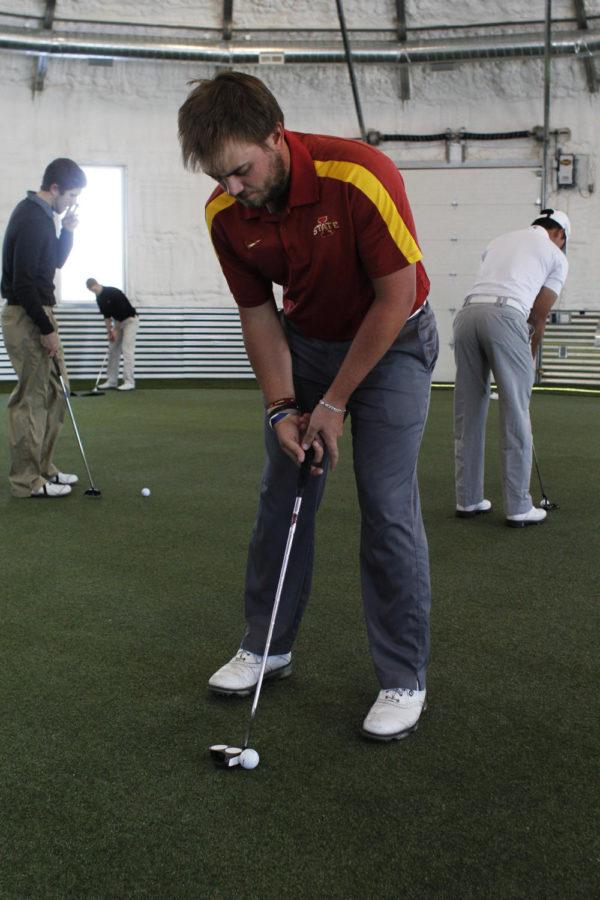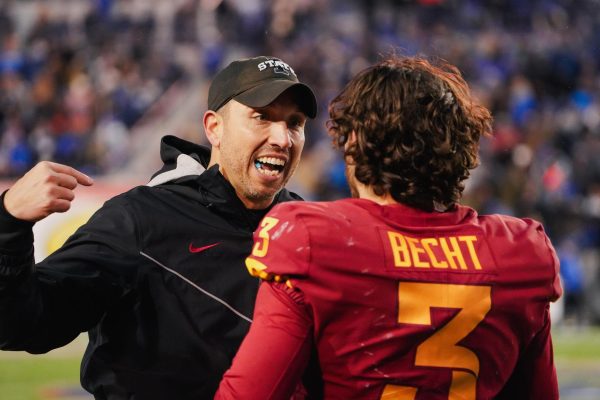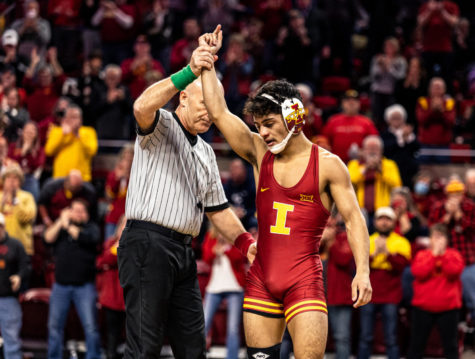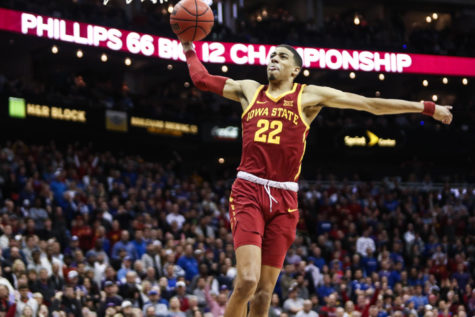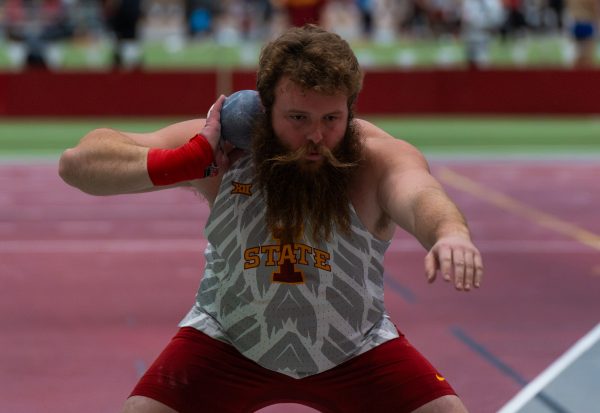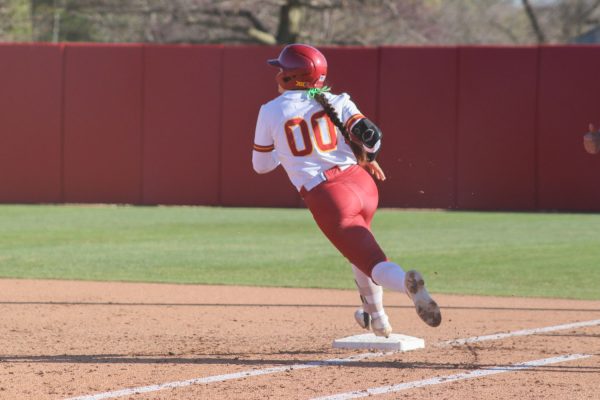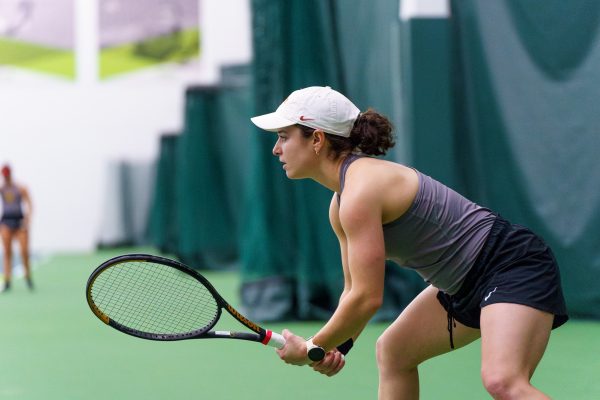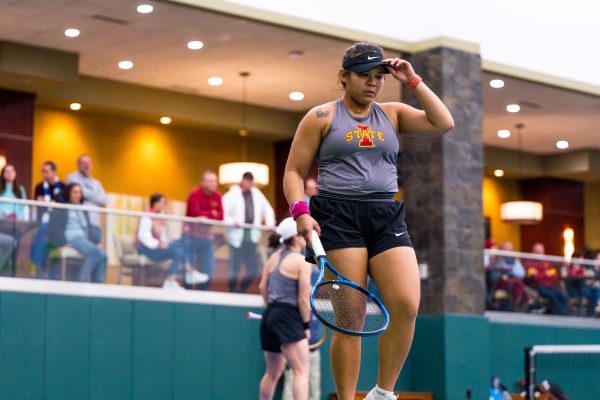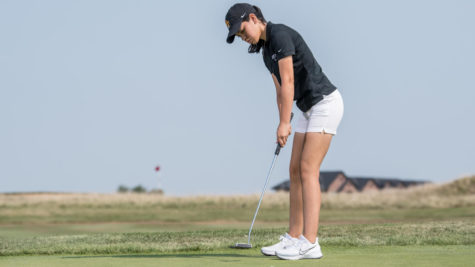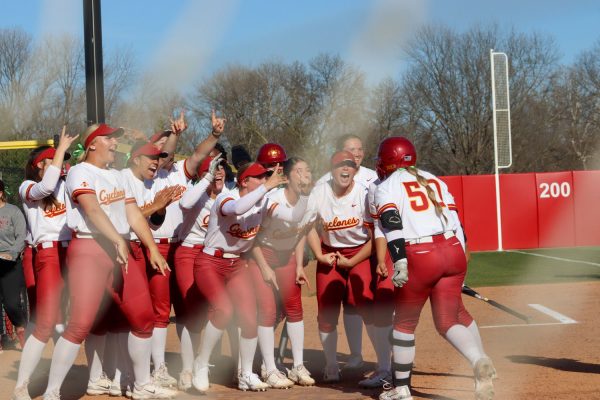ISU golfers seek competitive edge from workouts
Kelby Wingert/Iowa State Daily
Junior Sam Daley practices his putt on Feb. 26 at the golf team’s indoor practice facility.
December 16, 2014
As recently as 25 years ago, a golfer would not know a weight room from a waiting room.
Nowadays, thanks to a man by the name of Tiger Woods, fitness in golf has become essential at any level to become elite.
“There was a transformation on the PGA Tour on the highest level of golf back in 1997 when Tiger came onto the scene and dominated the sport for a number of years,” said Jeff Fronk, a strength and conditioning coach who has worked with the likes of PGA Tour golfers Jim Furyk, Billy Horschel and Vijay Singh.”
One of his quotes at that time in his career is that ‘the most important piece of equipment I have is my body.’”
As Tiger was blasting drives well over 300 yards and lapping the field with his skill and athleticism en route to six major championships in his first five years on Tour, the “Tiger effect” has led to a fitness boom, which has trickled down to the college and junior ranks.
At the Division I collegiate level, the men’s and women’s teams at Iowa State have embraced the trend and have had a regimented program in place for several years. The Cyclones work out with strength and conditioning coach Chris Clendenen five times per week in the offseason and two to three times per week in the regular season, depending on their tournament schedule.
Clendenen aims to help the golfers add strength, while also increasing mobility and flexibility to aid the golf swing.
“It’s going to be hamstrings, glutes, lower back and then you’re going to see over-active muscles: their hip flexors, deficiencies in their core,” Clendenen said of areas he looks for. “Getting their core stronger is going to be a big component of it, as well. I guess the three things I look for is their mobility, their general strength and then their core strength.”
Though the intensity and quantity of the workouts may be more than what golfers initially bargained for when coming to Iowa State, players have noticed the benefits reaped from staying in shape.
One benefit comes by an increased energy level at the rounds, an essential factor given that college golfers regularly play 36 holes in a day.
“I’ve actually struggled at the end of events,” said Sam Daley, a senior on the men’s team. “I wouldn’t say it’s [just] fatigue, but fatigue’s definitely a factor. I’d say now that I’m better at it, it’s just experience, knowing what to do in a situation. The fitter you are, the more you’re going to pay attention.”
Maintaining a high level of play at the end of rounds paid off for Daley, as he was able to finish strong at the Big 12 Championship for a second-place finish, the best ISU result at that event in 60 years.
While Daley entered Iowa State with some fitness experience at home in Australia, his counterpart on the women’s side, Chonlada Chayanun started from scratch upon her arrival from Thailand.
“I was surprised [to work out at Iowa State] because I never worked out in Thailand,” Chayanun, a senior from Nakhonratchaslma, Thailand, said. “I did nothing in Thailand, so it was kind of hard.”
After some initial hesitation, Chayanun hit the weight room hard. She quickly added strength and as she nears the end of her collegiate career, the fruits of her labor have begun to pay off.
“Working out helps me hit it further. Well, a lot further,” Chayanun said sheepishly. “Since my freshman year, I hit it 30 or 40 yards further.”
For men’s coach Andrew Tank, individual improvements have been made across the board but he also appreciates how the team-based workouts have improved camaraderie.
“They enjoy the team atmosphere, they’re in here as a team working out,” Tank said. “As an individual sport, we don’t get that as much.”
Doubts can creep in regarding if all of the hours in the gym are time best spent versus fixing a balky putting stroke or hitting another bucket of balls, but Tank said he and the training staff are vigilant in maintaining a proper balance.
“That’s an important balance, I think that’s something we’re always trying to look at because you only have so many hours you can use in the week,” So we try to look at where we are in the season and cater to that,” Tank said.
Whether or not Iowa State has found the perfect mix of practice versus training, the team’s regimen provides players an opportunity to state their case that golfers are in fact athletes.
“You don’t have to [work out], I guess. You see plenty of Tour players that might see a gym once a week or once a month, but most of the top guys are in the gym consistently and they’re pretty good and pretty fit,” Daley said.
“One of my mates said, ‘What do you need fitness for golf for? You just chase a little white ball around a field,’ but hey, it’s a competitive sport these days, there’s a lot of players always looking for that competitive edge.”

